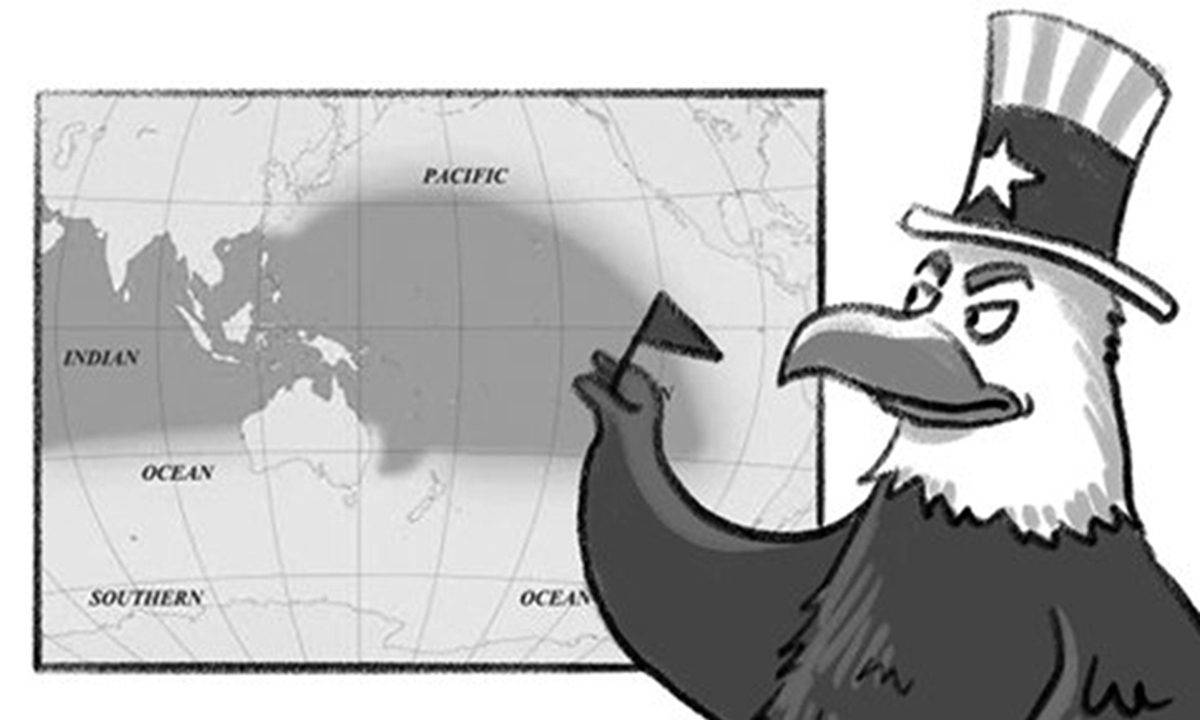
US and the Indo-Pacific Illustration: Liu Rui/GT
The US Indo-Pacific Command (INDOPACOM) delivered a report on Monday to Congress, calling for roughly $27 billion in additional spending between 2022 and 2017, with an eye to "boost deterrence against China," according to Defense News.
The INDOPACOM is now calling for "new missiles and air defenses, radar systems, staging areas, intelligence-sharing centers, supply depots and testing ranges throughout the region, as well as exercises with allies and partners."
INDOPACOM's request is for additional expenditures to back up new US military actions in the Indo-Pacific region. The US aims to create a large quasi-alliance system by integrating its allies and close partners. For instance, it hopes to bring together military forces of countries including Japan, Australia, even India, through joint military drills and trainings. It's assumed that the $27 billion deterrence fund will first be used for organizing multilateral exercises in the Indo-Pacific region. Besides, it will also be used for purchasing new weapons, facilitating new construction and closer military collaboration with US allies in the region.
This is not the first time that INDOPACOM has sought additional spending to boost deterrence against China. A $20 billion wish list, which was taken as, "the basis for a new Pacific-focused pot of money to deter Chinese military action in the region," was submitted to Congress last April, according to Defense News.
It's fair to say that INDOPACOM could not find any other pretense except China to strengthen its military capabilities. As China's military strength has grown stronger, the US military has put some dangerous labels on China. Labeling China as a "threat" and creating a sense of fear toward China among Americans could help the US military gain more budgets. This is an old trick played by the US military for a long time, and it will continue in the future.
China's increasing military strength, in fact, hasn't posed any threats to its surrounding countries, nor nations in the Indo-Pacific region. China has insisted on solving disputes through peaceful means and negotiations. China has never used military strength to coerce or directly attack others as the US often does. China is in a state of peaceful rise. But the US is turning a blind eye to this and insists on putting labels on us. It mainly wants to hype up the "China threat" theory and find excuses for itself to improve military offensive capabilities and consolidate US military hegemony.
INDOPACOM chief Adm. Philip Davidson, who drafted the report to call for the $27 billion deterrence fund, said his top priority is to establish an Aegis Ashore system on Guam by 2026, which would help protect US citizens and forces there. The US now attaches great importance to Guam. It believes that Guam is a major strategic springboard for military deterrence against China, because American strategic bombers can take off from the island to deter China in the air, especially strategic stealth bombers.
China's missile capabilities are now very strong too. Our ballistic missiles are able to reach Guam. But China is not targeting Guam at all. However, the US is afraid that once it provokes or intimidates China, Guam - one of the US' major base camps - will be a target of China's retaliation. Thus, Washington wants to build a complete anti-missile system so that it can provoke Beijing unscrupulously.
Militarily, the US regards China as its major strategic rival. This does not mean that it will launch a direct military offensive against China, but it reflects the fact that the US still has a Cold War mentality toward China.
The US does not wish to see China's maritime and air strength go far and it wants to stop China at its doorstep. But from the perspective of China's marine forces, China has two aircraft carriers and the Type 075 amphibious assault ship. The US cannot prevent China's marine forces from going out to distant seas. Similarly, China is expected to develop more advanced strategic bombers. China's rising national strength will help boost the development of its military capabilities.
The military maneuvers of US forces in the Pacific region come completely from a Cold War mentality. The US is unhappy about China's rise and its growing influence and military power. As China is not a US ally, it views China as its rival and works to contain us both militarily and strategically. Consequently, the US will invest in more forces.
China should develop according to its own strategic rhythms. It should continue to enhance its comprehensive national strength, including its military capabilities. Even if the US wants to make provocations, it should give a second thought. The purpose of China's military development is to protect its overseas interest, as well as counterbalance some hegemonic powers with ulterior motives.
China and the US will engage in competition at the strategic and military level. They will remain wrestling without their ties being broken. In other words, there is little likelihood of a war or a conflict will occur between the two. At the military level, China and the US have remained rational. The crisis management mechanisms between the two are mature, despite frictions from time to time.
The author is a Beijing-based military analyst. opinion@globaltimes.com.cn




